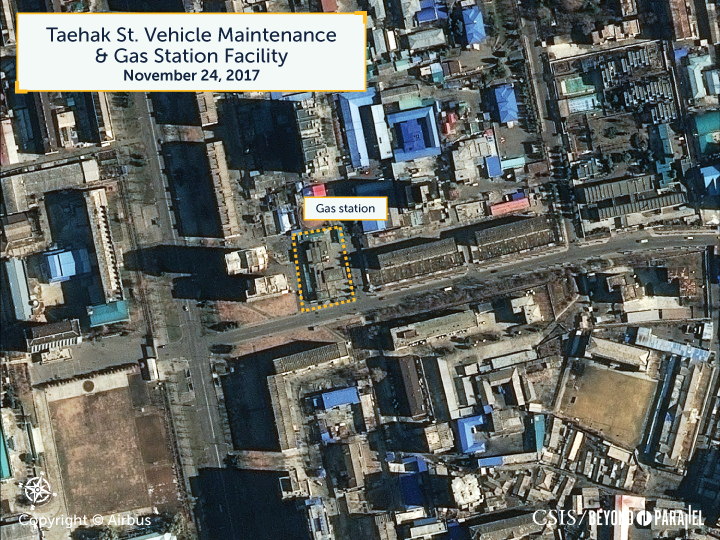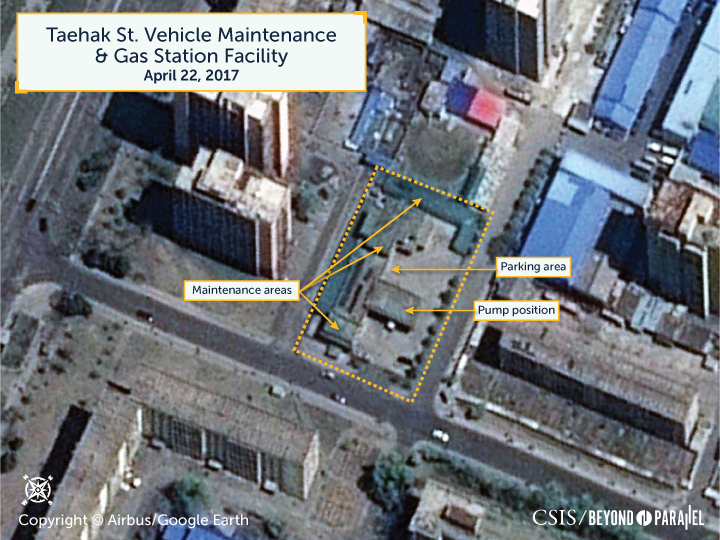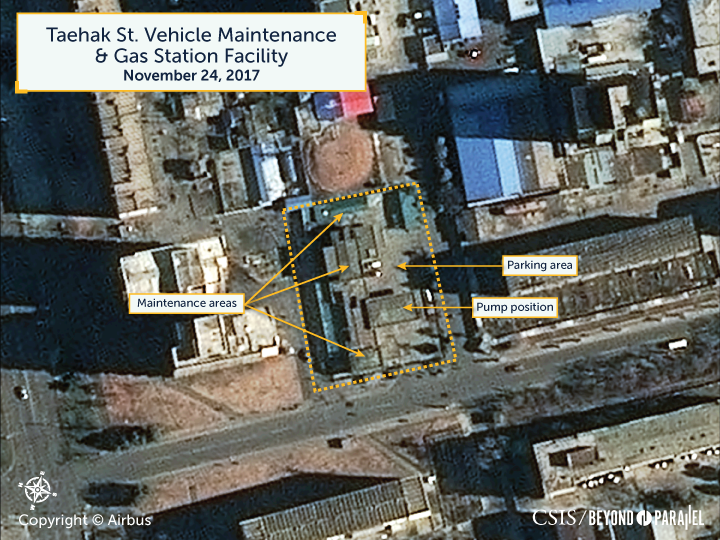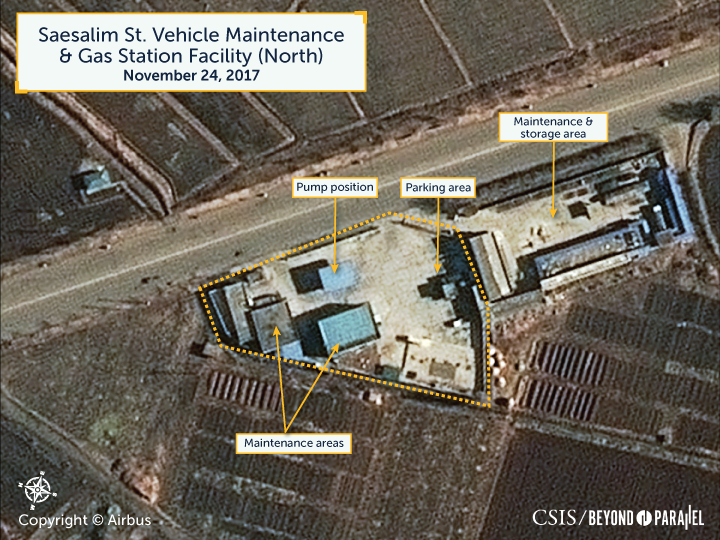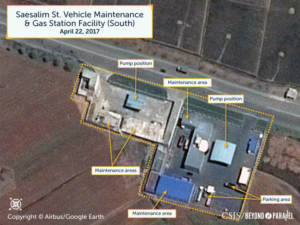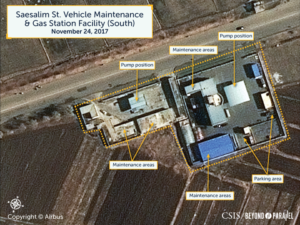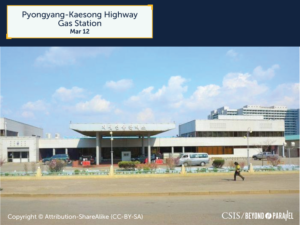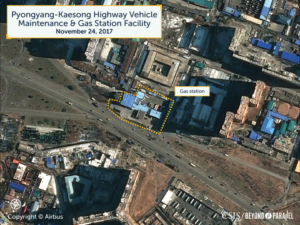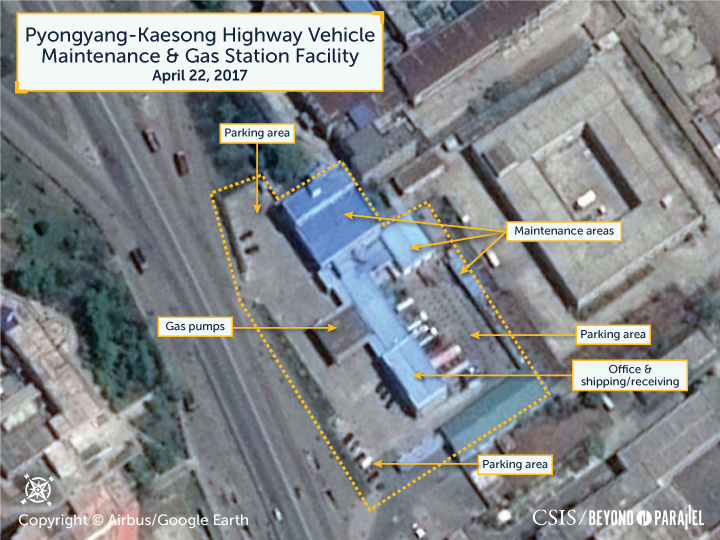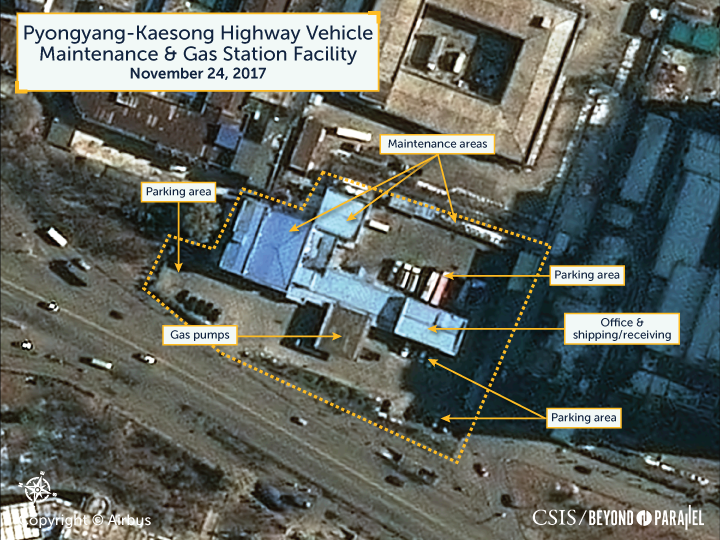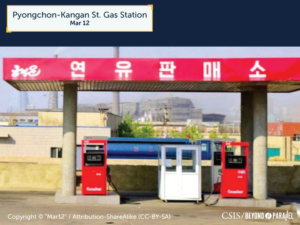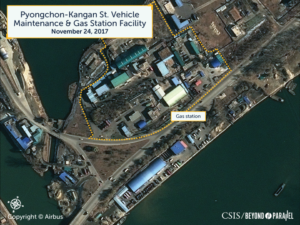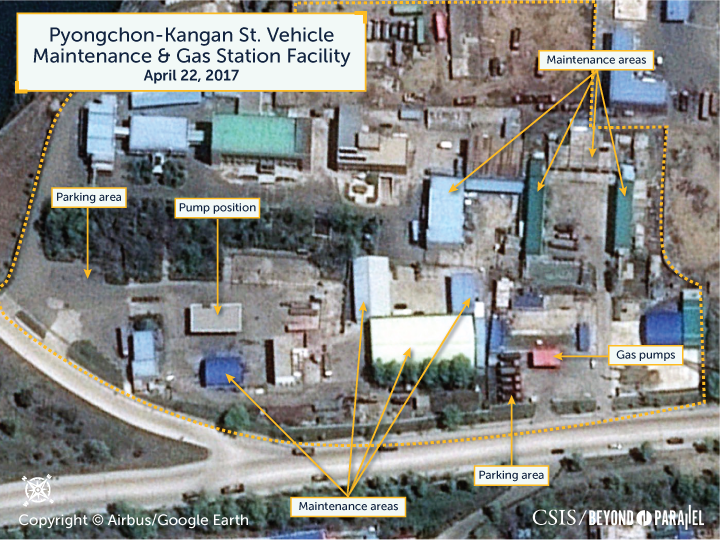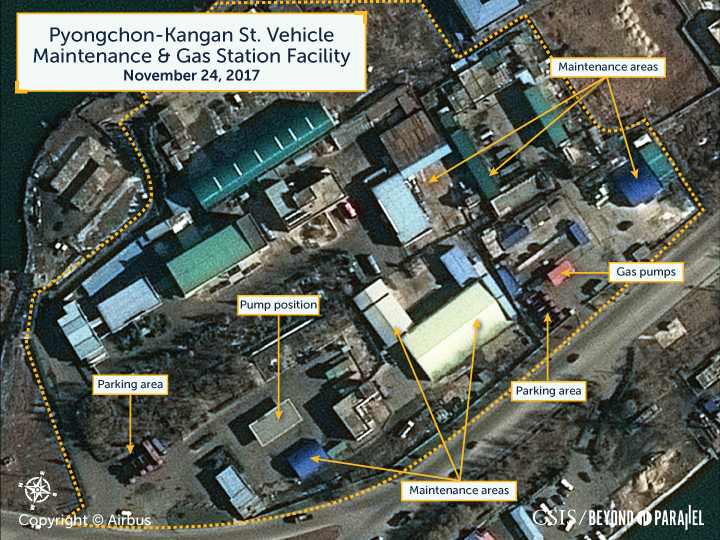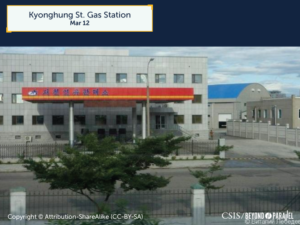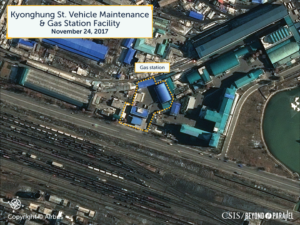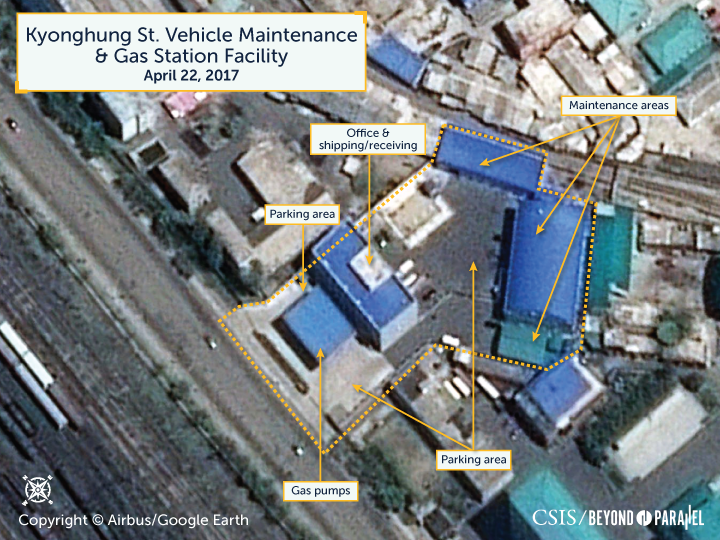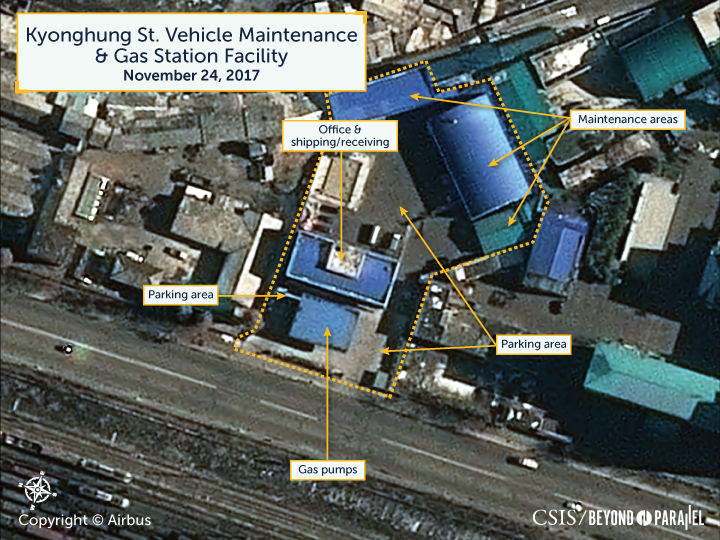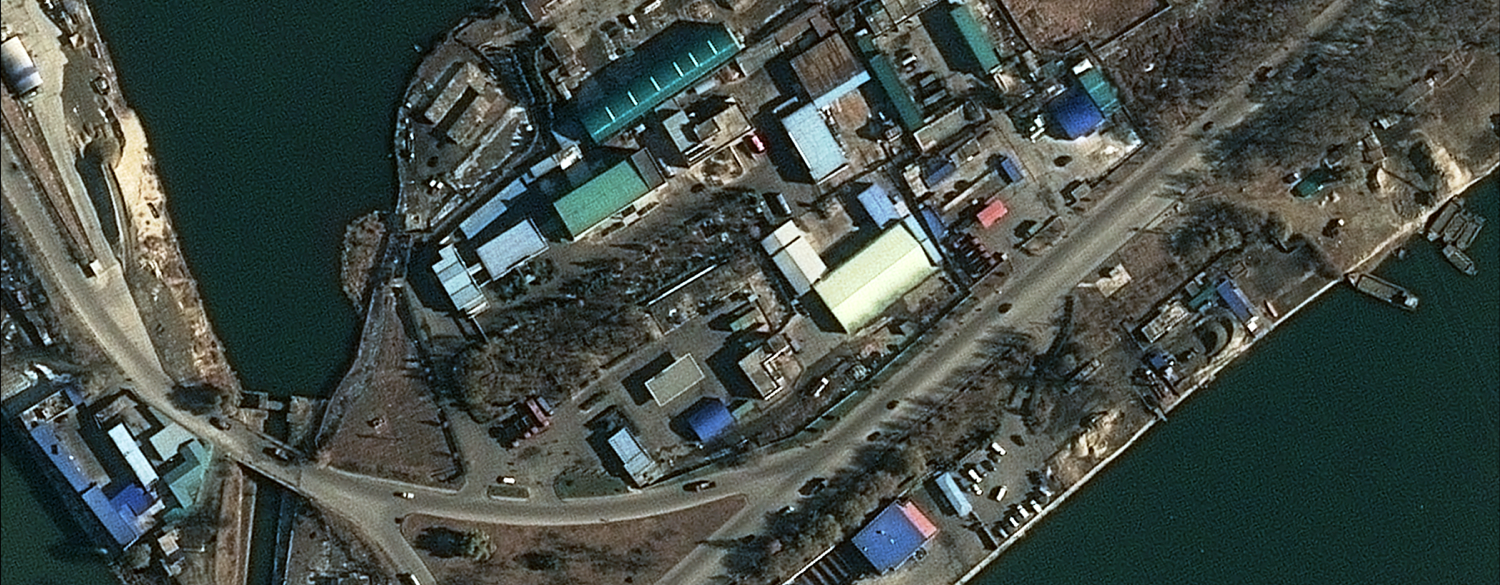
Pyongyang Gas Stations and Fluctuating Fuel Prices
In July 2017, unconfirmed reports circulated about dramatically fluctuating gasoline and diesel prices in North Korea. Although these reports may have originated from within the defector community and were largely unverified, speculation mounted that the Chinese state oil company, China National Petroleum Corp (CNPC), would suspend fuel sales to North Korea. According to the reports, this would be China’s response to the continued testing of ballistic missiles by North Korea.1 This move would have significant policy and economic implications as North Korea acquires the majority of its petroleum products from China with a significantly small quantity coming from Russia. Analysis of satellite imagery from around this period, however, indicates that a suspension of any significant length does not appear to have happened.
Three months later reports emerged again alleging that North Korea was experiencing dramatic fluctuations in gasoline and diesel prices.2 After North Korea’s September 3rd nuclear test, there were more ruminations that China would suspend or limit fuel exports to the North as a result of a new anticipated round of international sanctions. Once again, these reports primarily originated from within the defector community,3 yet were later reinforced by a September 17, 2017 tweet from President Donald Trump.4
I spoke with President Moon of South Korea last night. Asked him how Rocket Man is doing. Long gas lines forming in North Korea. Too bad!
— Donald J. Trump (@realDonaldTrump) September 17, 2017
Other reports assert that while speculation over additional sanctions had in fact resulted in significant fluctuations in gasoline and diesel prices in Pyongyang, life was relatively normal and that there were no long gas lines.5
Analysis
In an attempt to gain some insight into whether the speculation and resulting fluctuation in fuel prices reported above might have any long-term impact upon gas stations in Pyongyang,6 Beyond Parallel selected a representative sample of six facilities dispersed around the city to be examined by comparing commercial satellite images from April 22, 2017 and November 24, 2017—before and after the July-September reports. These facilities are:
Pyongyang Gas Stations (Select Sample)
Taehak Street Station
Located in the built-up diplomatic section on the east side of city, and just off Taehak Street, this is one of the smaller vehicle maintenance and gas station facilities in Pyongyang. Significantly, it is centrally located to the nearby foreign embassies that it serves. The facility consists of a moderate-sized island for fuel pumps, several small office buildings, parking area, and minor maintenance and repair structures. One vehicle was observed at the fuel pumps in April, and three trucks or vans were present in parking areas during November. A number of vehicles are observed traveling on streets around the facility on both dates.
Saesalim Street Station (North)
Located on the southeast outskirts of the city this facility consists of a small island with fuel pumps, several small office buildings, a parking area, minor maintenance and repair structures and an attached storage/shipping yard.
While two small vehicles were observed in April only two trucks are present in November—an insignificant difference. No vehicles were observed at the fuel pumps on either date. One or two vehicles were observed traveling on Saesalim Street near the facility on both dates.
.
Saesalim Street Station (South)
Located approximately 200 meters south of Saesalim Street (North) this facility consists of a medium-sized island for fuel pumps, a large office building, a parking area, and several moderate-size maintenance and repair structures. Attached to the facility is a separate walled facility with a small island for fuel pumps, a small office and what appear to be several small maintenance or repair buildings. Four trucks and one small vehicle were observed both dates. At the attached walled facility one truck was observed in April and one small vehicle in November. No vehicles were observed at the fuel pumps on either date. As with the facility in the north, one or two vehicles were observed traveling on Saesalim Street near the main structures on both dates.
……………………
The reason for placing these two apparently redundant facilities in such close proximity to one another is unclear. Both appear operational in both images, which suggest that they may serve different segments of the government or economy. This, however, remains to be confirmed.
Pyongyang-Kaesong Highway Station
Located on the major Pyongyang-Kaesong Highway, in the southern built-up residential section of the city, this is a moderately sized facility consisting of a medium-sized island for fuel pumps, a large office building, several parking areas, and moderate maintenance and repair structures. Ground imagery shows that the fuel pump island contains two or three pumps. As is befitting their location, the facility and highway are active in both April and November with numerous vehicles at the pumps and in the parking areas. The facility has what appears to be a shipping/receiving building (or cargo transfer station) at which a number of trucks are seen on both dates. Ground imagery suggests that the street side of this building may include a restaurant.7
Ground view (left) and aerial view (right) of Pyongyang-Kaesong Highway gas station, enlarged images below.
.
Pyongchon-Kangan Street Station
Of the facilities examined for this report this is the largest and appears to be the headquarters for a construction-related enterprise with a fleet of large trucks.8 Located on the west side of the city, it is composed a number of large administrative office buildings, truck storage yards, maintenance and repair buildings, a moderate-size truck fuel pump station, parking areas for trucks, and a small gas station with a small island for fuel pumps. Ground imagery shows that the small island contains two, possibly three, pumps. No trucks or vehicles are present at the fuel pumps in either the April or November images. There are numerous large trucks distributed throughout the facility in both images. Significant numbers of trucks and smaller vehicles are visible on Pyongchon-Kangan Street, the adjoining streets and the various parking areas in both images.
Ground view (left) and aerial view (right) of Pyongchon-Kangan Highway gas station, enlarged images below.
.
Kyonghung Street Station
Located in the industrial section, on the north side of the city, this is a moderately-sized facility consisting of a medium-sized island for fuel pumps, a large office building, several parking areas, and several moderate-size maintenance and repair structures. As with the Pyongyang-Kaesong Highway facility it appears that the office building may also contain a shipping/receiving building (or cargo transfer station) at which a number of trucks are seen on both dates. Ground imagery shows that the fuel pump island contains four pumps. No vehicles were observed at the fuel pumps. However, five-six trucks and vehicles are observed in the parking areas and three to four other vehicles are seen traveling on Kyonghung Street in both images.
Ground view (left) and aerial view (right) of Kyonghung gas station, enlarged images below.
.
Assessment
A number of characteristics are readily apparent across the images from April 22 and November 24, 2017:
- Unlike gasoline stations typically seen in South Korea, those in Pyongyang are usually components of larger vehicle maintenance or shipping/receiving facilities that appear to have separate fueling stations for both small vehicles and larger trucks.
- All the facilities examined appear to be in a relatively good state of repair and operational.
- While individual cars or trucks were observed at fuel pumps no lines of vehicles were observed queued for fueling.
- Traffic patterns within and immediately surround the facilities were essentially unchanged.
While the satellite imagery used in this analysis cannot determine whether the reports of long gas lines in Pyongyang or reports of dramatic fluctuations in gasoline and diesel fuel pricing that allegedly occurred during the July-September period are valid, it does indicate that if they did occur they do not appear to have had any long-lasting effects upon either the facilities themselves or the general volume or pattern of vehicle traffic in the city. With regard to the latter it should be noted that with the exception of national level events (e.g., military parades, cultural celebrations, etc.) traffic levels, as well as total number of vehicles present, in Pyongyang are some of the lowest in East Asian cities of comparable size.
References
- “Fuel prices in North Korea surge after China cuts oil sales,” Business Insider, July 17, 2017, http://www.businessinsider.com/north-korea-fuel-prices-surge-after-china-cuts-oil-sales-2017-7. ↩
- Kang Mi Jin and Kim Ga Young. “Gas prices in North Korea jump on rumors of possible embargo,” DailyNK, September 15, 2017, http://www.dailynk.com/english/read.php?num=14718&cataId=nk01500; Robinson, Melia. “North Korea has launched a bike-sharing scheme to alleviate its apparent fuel shortage,” Business Insider, September 20, 2017, http://www.businessinsider.com/bike-sharing-comes-to-pyongyang-north-korea-2017-9; O’Carroll, Chad. “Petrol prices up by 43% in North Korean capital: source,” NK News, September 21, 2017, https://www.nknews.org/2017/09/petrol-prices-up-by-43-in-north-korean-capital-source/; Silberstein, Benjamin Katzeff. “Gas prices volatile in Pyongyang as tensions run high,” North Korea Economic Watch, September 25, 2017, http://www.nkeconwatch.com/category/energy/gasoline/; and Ah Seol Song. “Volatile gasoline prices in Pyongyang,” DailyNK, September 25, 2017, http://www.dailynk.com/english/read.php?cataId=nk01500&num=14736. ↩
- Ibid. ↩
- Twitter account of Donald Trump, September 17, 2017, https://twitter.com/realdonaldtrump/status/909384837018112000?lang=en. ↩
- Fifield, Anna. “Trump’s claim there were long gas lines in North Korea has residents puzzled,” Washington Post, September 18, 2017, https://www.washingtonpost.com/news/worldviews/wp/2017/09/18/trumps-claim-there-were-long-gas-lines-in-north-korea-has-residents-puzzled/?utm_term=.26a1b1cd248d. ↩
- Although the term “gas station” is used throughout this report it is likely that these facilities also sell diesel fuel. ↩
- While at first glance this building could be taken for a simple truck stop, all the trucks are seen backed into the building suggesting load/unloading operations. ↩
- This facility maybe associated with the truck facility on the south side of Pyongchon-Kangan Street. ↩

